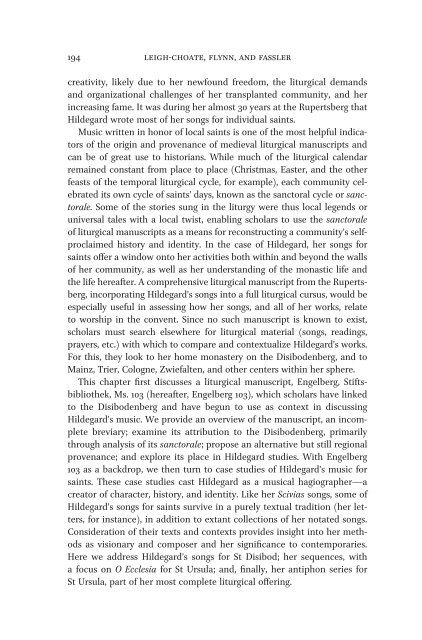A Companion to Hildegard of Bingen
Beverly Mayne Kienzle, Debra L. Stoudt & George Ferzoco, "A Companion to Hildegard of Bingen". BRILL, Leiden - Boston, 2014.
Beverly Mayne Kienzle, Debra L. Stoudt & George Ferzoco, "A Companion to Hildegard of Bingen". BRILL, Leiden - Boston, 2014.
- TAGS
- hildegard-of-bingen
Create successful ePaper yourself
Turn your PDF publications into a flip-book with our unique Google optimized e-Paper software.
194 leigh-choate, flynn, and fassler<br />
creativity, likely due <strong>to</strong> her newfound freedom, the liturgical demands<br />
and organizational challenges <strong>of</strong> her transplanted community, and her<br />
increasing fame. It was during her almost 30 years at the Rupertsberg that<br />
<strong>Hildegard</strong> wrote most <strong>of</strong> her songs for individual saints.<br />
Music written in honor <strong>of</strong> local saints is one <strong>of</strong> the most helpful indica<strong>to</strong>rs<br />
<strong>of</strong> the origin and provenance <strong>of</strong> medieval liturgical manuscripts and<br />
can be <strong>of</strong> great use <strong>to</strong> his<strong>to</strong>rians. While much <strong>of</strong> the liturgical calendar<br />
remained constant from place <strong>to</strong> place (Christmas, Easter, and the other<br />
feasts <strong>of</strong> the temporal liturgical cycle, for example), each community celebrated<br />
its own cycle <strong>of</strong> saints’ days, known as the sanc<strong>to</strong>ral cycle or sanc<strong>to</strong>rale.<br />
Some <strong>of</strong> the s<strong>to</strong>ries sung in the liturgy were thus local legends or<br />
universal tales with a local twist, enabling scholars <strong>to</strong> use the sanc<strong>to</strong>rale<br />
<strong>of</strong> liturgical manuscripts as a means for reconstructing a community’s selfproclaimed<br />
his<strong>to</strong>ry and identity. In the case <strong>of</strong> <strong>Hildegard</strong>, her songs for<br />
saints <strong>of</strong>ffer a window on<strong>to</strong> her activities both within and beyond the walls<br />
<strong>of</strong> her community, as well as her understanding <strong>of</strong> the monastic life and<br />
the life hereafter. A comprehensive liturgical manuscript from the Rupertsberg,<br />
incorporating <strong>Hildegard</strong>’s songs in<strong>to</strong> a full liturgical cursus, would be<br />
especially useful in assessing how her songs, and all <strong>of</strong> her works, relate<br />
<strong>to</strong> worship in the convent. Since no such manuscript is known <strong>to</strong> exist,<br />
scholars must search elsewhere for liturgical material (songs, readings,<br />
prayers, etc.) with which <strong>to</strong> compare and contextualize <strong>Hildegard</strong>’s works.<br />
For this, they look <strong>to</strong> her home monastery on the Disibodenberg, and <strong>to</strong><br />
Mainz, Trier, Cologne, Zwiefalten, and other centers within her sphere.<br />
This chapter fijirst discusses a liturgical manuscript, Engelberg, Stiftsbibliothek,<br />
Ms. 103 (hereafter, Engelberg 103), which scholars have linked<br />
<strong>to</strong> the Disibodenberg and have begun <strong>to</strong> use as context in discussing<br />
<strong>Hildegard</strong>’s music. We provide an overview <strong>of</strong> the manuscript, an incomplete<br />
breviary; examine its attribution <strong>to</strong> the Disibodenberg, primarily<br />
through analysis <strong>of</strong> its sanc<strong>to</strong>rale; propose an alternative but still regional<br />
provenance; and explore its place in <strong>Hildegard</strong> studies. With Engelberg<br />
103 as a backdrop, we then turn <strong>to</strong> case studies <strong>of</strong> <strong>Hildegard</strong>’s music for<br />
saints. These case studies cast <strong>Hildegard</strong> as a musical hagiographer—a<br />
crea<strong>to</strong>r <strong>of</strong> character, his<strong>to</strong>ry, and identity. Like her Scivias songs, some <strong>of</strong><br />
<strong>Hildegard</strong>’s songs for saints survive in a purely textual tradition (her letters,<br />
for instance), in addition <strong>to</strong> extant collections <strong>of</strong> her notated songs.<br />
Consideration <strong>of</strong> their texts and contexts provides insight in<strong>to</strong> her methods<br />
as visionary and composer and her signifijicance <strong>to</strong> contemporaries.<br />
Here we address <strong>Hildegard</strong>’s songs for St Disibod; her sequences, with<br />
a focus on O Ecclesia for St Ursula; and, fijinally, her antiphon series for<br />
St Ursula, part <strong>of</strong> her most complete liturgical <strong>of</strong>ffering.
















